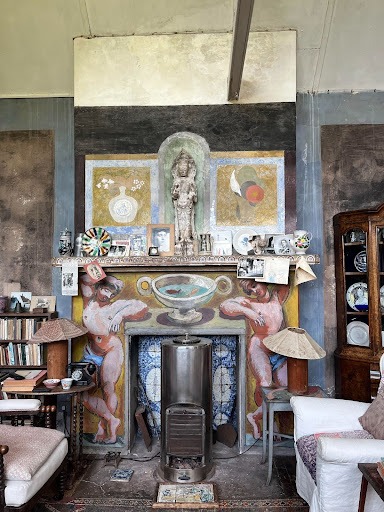By Lydia Firth
Having recently moved to Sussex, I was excited by the prospect of rolling hills, proximity to London, and new cultural hotspots. Charleston House quickly made my list of places to visit. Charleston was the home and studio of the painters Vanessa Bell and Duncan Grant, and it became a meeting point for the Bloomsbury Set: a group of artists, intellectuals, writers, and philosophers in early 20th century England. Frequent visitors to the house included Virginia Woolf and her husband Leonard, alongside the great E.M. Forster. The house itself is positioned among a truly novelistic English garden full of dahlias and drooping trees in the orbit of a pond laden with lily pads. Perhaps it was just the haziness of the hot September day on which I visited, but it felt quite genuinely magical.
For magpie-minded individuals like me, the house is an absolute treasure trove of stunning interiors and objects. Each room is so delightfully curated and reflects the Bloomsbury group’s originality and collaboration. No surface is left untouched, and each object is handcrafted. The side of the bath is adorned with a painting of a reclining nude; fired in the house’s own kiln, the kitchen sink tiles are painted with pink silky fish; a lampshade made from a painted colander pleasantly throws out gentle stripes of light; rugs lay supine and hand-tied in a myriad of colours. A bust of Virginia Woolf casually placed in a bedroom window reminds me of the time she spent here.
Above and below the window of Bell’s old bedroom, Grant elegantly depicted both a cockerel and the family’s lurcher to wake her in the morning and guard her by night. This epitomises the consideration put into the design of their home – it exists as a little in-joke between the couple, as well as being ornamental.
There is precision in the artistic curation from room to room: the colour palette melds the house together in one harmonious aesthetic, punctuated by the consistent display of Bell and Grant’s paintings throughout. As well as seeming calculated, the design retains its spontaneity in both the freehand murals which cover doors, chairs, bedheads, and the thin washes of warm-toned paints which coat walls, brushstrokes peeking through. It could be described as ‘interior design nonchalance’: colours, shapes, and patterns obviously came very naturally to the residents. There is a surprising sense of the contemporary, and the textiles, colour palette and adorned furniture remind me of the likes of Oliver Bonas and Anthropologie. Writer and curator Charlier Porter points out the irony “that Charleston inspires stuff that gets mass-produced, because what the house asks you to do, always, is to think for yourself.”
Whilst the house is preserved exactly as it was, the space remains dynamic. An unpainted pelmet may appear tomorrow with a little floral flourish, for example. The lack of stagnation speaks to their authenticity and reflects their ideology. Grant himself was originally drawn thereto because the agricultural work that the house implied his part in made him exempt from conscription from WWI – perhaps a literal lifeline for the conscientious objector. Furthermore, it meant that the visitors of Charleston’s unconventional and often intertwining romantic lives were able to play out in what was a counter-cultural refuge from London life. Dorothy Parker quipped that the Bloomsbury Group “lived in squares, painted in circles, and loved in triangles”. The house could almost be seen as one of the members of the group: it feels like both a companion and a living representation of their dislike for convention. Indeed, the level of detail employed on every surface and in every corner cements it as an externalisation of their ethos.
I urge you to visit and enjoy this submersion into 20th century artistic living.

